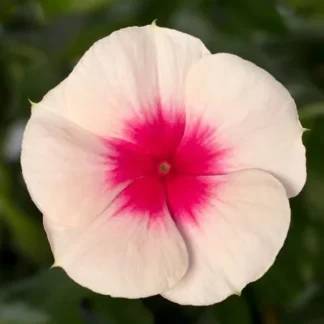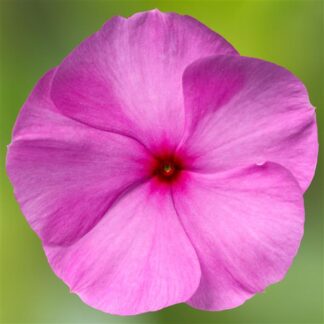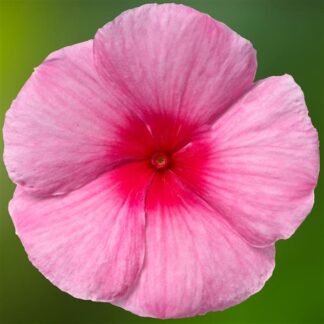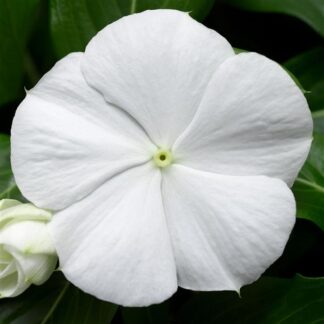Vinca
Grow and Care for Vinca: A Bright and Easy Garden Favorite
If you’re looking for a tough, colorful, and low-maintenance plant to brighten up your garden or landscape, vinca might just be the perfect choice. Known for its cheerful blooms and glossy green leaves, the vinca flower is one of the easiest plants to grow. Whether you’re new to gardening or just need something that thrives with little care, vinca annuals are ready to impress.
Let’s explore what makes this flower so special, how to plant it, and how to keep it blooming all season long.
What is Vinca?
Vinca, also called Madagascar periwinkle, is a heat-loving flowering plant that thrives in full sun and dry conditions. It is known for its colorful blooms that range from pink, red, and purple to white. Vinca is typically grown as an annual, which means it completes its life cycle in one growing season. However, in warm climates, it can come back year after year.
The vinca flower is small but eye-catching, with a flat, five-petaled shape that blooms continuously through summer and fall. Each plant forms a mound of dark green foliage that can spread out nicely in the garden or a container.
Why Gardeners Love Vinca
Here’s why so many gardeners can’t get enough of vinca plants:
- Tolerates Heat and Drought: Vinca thrives when the heat is on. It doesn’t need much water and won’t wilt under the sun.
- Long Blooming Season: From late spring until the first frost, vinca flowers just keep coming.
- Low Maintenance: Once established, vinca requires very little care.
- Pest and Disease Resistant: Unlike some flowers, vinca is rarely bothered by insects or plant diseases.
- Great in Containers or Beds: Whether in hanging baskets, pots, or garden borders, vinca looks good anywhere.
Vinca Plants for Sale
You can find vinca plants for sale at garden centers, nurseries, and online shops in spring. They’re often sold in flats, small pots, or hanging baskets, making them easy to plant right away.
Look for healthy plants with rich green leaves and a few buds ready to bloom. Avoid any plants with yellowing leaves or soggy soil, as this could be a sign of root rot.
Growing Vinca in Pots
Want to grow vinca on your porch or patio? No problem!
- Use pots with drainage holes.
- Choose a lightweight potting mix.
- Place in full sun.
- Water when the soil is dry to the touch.
Vinca in containers can trail over the sides or stay bushy and upright, depending on the variety. Either way, it brings a pop of color to any space.
Types of Vinca
There are a few different types of vinca you might find for sale. Each has its own special look:
1. Upright Vinca
These grow upright and bushy, usually 12–18 inches tall. Perfect for flower beds.
2. Trailing Vinca
Also known as spreading vinca, these types have a more trailing habit, making them ideal for hanging baskets and containers.
3. Dwarf Vinca
These are compact and stay under 10 inches tall. Great for small spaces or front borders.
Colors include:
- Bright pink
- Deep red
- Lavender
- White with red center
- Pure white
- Bi-color blends
Mix and match for a vibrant garden show!
Wrap-Up: Why You’ll Love Vinca
To sum it up, vinca flowers are beautiful, strong, and simple to care for. With bright blooms, strong stems, and a carefree attitude, vinca annuals are a go-to plant for gardeners everywhere.
If you’re searching for vinca plants for sale, shop early in the spring so you can enjoy their blooms all summer long. From flower beds to pots and hanging baskets, there’s a vinca variety perfect for your space.
Try vinca this season—and let your garden shine with color, charm, and ease.
Ready to grow vinca?
Pick your favorite colors, plant in the sun, and let the blooms begin! 🌸
Shop for Vinca Plants and Seeds
Showing all 6 results
-

Vinca, Cora® Cascade XDR Apricot
$2.49 – $7.99 Select options This product has multiple variants. The options may be chosen on the product page -

Vinca, Cora® Cascade XDR Lilac
$2.49 – $7.99 Select options This product has multiple variants. The options may be chosen on the product page -

Vinca, Cora® Cascade XDR Polka Dot
$2.49 – $7.99 Select options This product has multiple variants. The options may be chosen on the product page -

Vinca, Cora® Cascade XDR Punch
$2.49 – $7.99 Select options This product has multiple variants. The options may be chosen on the product page -

Vinca, Cora® Cascade XDR Strawberry
$2.49 – $7.99 Select options This product has multiple variants. The options may be chosen on the product page -

Vinca, Cora® Cascade XDR White
$2.49 – $7.99 Select options This product has multiple variants. The options may be chosen on the product page
How to Plant Vinca
Planting vinca annuals is simple. Follow these steps for a strong start:
1. Choose a Sunny Spot
Vinca loves the sun. Pick a location that gets 6 or more hours of sunlight each day. While it can tolerate part shade, it will bloom best in full sun.
2. Prepare the Soil
Vinca prefers well-draining soil. If your soil holds too much water, mix in compost or sand to improve drainage. Raised beds and containers are also great options.
3. Plant with Space
Space plants about 8 to 12 inches apart to allow for airflow and growth. Dig a small hole for each plant, set it in, and cover the roots with soil. Press gently around the base.
4. Water Gently
Give your vinca a drink after planting, but don’t overdo it. Vinca doesn’t like “wet feet.” Water just enough to help the roots settle in.
How to Care for Vinca
Once your vinca plants are in the ground, caring for them is easy. Here’s what they need:
1. Watering
Water deeply but only when the soil is dry. Overwatering can lead to root rot, which is one of the few problems vinca can face. In dry spells, water about once a week.
2. Feeding
Vinca isn’t a heavy feeder, but giving it a boost can help it flower more. Use a balanced liquid fertilizer every 4–6 weeks or a slow-release fertilizer at planting time.
3. Deadheading? Not Needed
Many flowers need deadheading (removing spent blooms) to keep going, but not vinca! It cleans itself and will keep blooming without extra help.
4. Mulching
Add a layer of mulch around your plants to keep weeds down and help retain moisture. Just don’t pile it up against the stems—leave a little space.
Common Questions About Vinca
Is vinca an annual or perennial?
In most of the U.S., vinca is grown as an annual. In frost-free zones (USDA Zones 10–11), it can survive as a perennial.
Can vinca grow in shade?
Vinca tolerates light shade but performs best in full sun. Too much shade means fewer flowers.
How often should I water vinca?
Let the soil dry out between waterings. Once a week is usually enough, even in hot weather.
Is vinca good for beginners?
Absolutely. It’s one of the easiest flowers to grow and thrives even with minimal attention.
Showing all 6 results





